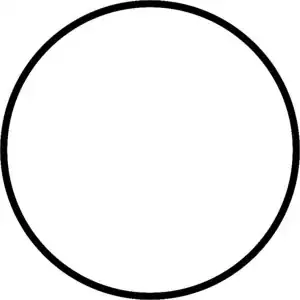A few notes on @YvesDaoust's answer (my edit was not accepted, so I post the notes as an additional answer).
Let $\mathcal{C}$ be the euclidean unit circle in $\mathbb{R}^2$ defined by $x^2 + y^2 = 1$.
1) Using a $p$-norm $||\cdot||_p$, the circumference of $\mathcal{C}$ will be $$h_p=2\int_0^{\pi}\sqrt[p]{|\cos t |^p+|\sin t|^p}\,dt,$$
which grows to infinity for $p\to0$. But for it to be a norm, one must have $p\ge1$.
From this integral we have
$$h_{10} \approx 5.68...$$
$$h_2=2 \pi \approx 6.28...$$
$$h_{1.5} \approx 6.74...$$
$$h_1=8$$ and can't achieve higher value than $h_1$ with a $p$-norm.
2) Let the diameter and radius be defined by
$$d_p = \max\limits_{a, b \in \mathcal{C}} ||a-b||_{p}$$
$$r_p = \max\limits_{x^2+y^2=1} \{ (|x|^p + |y|^p)^{1/p} \}$$
When $1 \leq p \leq 2$, by symmetry, we can find that
$$r_p=\sqrt[p]{\frac1{\sqrt2^p}+\frac1{\sqrt2^p}}=\frac{\sqrt[p]2}{\sqrt2}=2^{1/p - 1/2}.$$
As noted by user @gniourf_gniourf, this is no more true when $p \geq 2$.
When $p \geq 2$, $r_p = 1$.
If we evaluate $d_p$ in a similar fashion, we see that $d_p = 2\ r_p = 2^{1/p + 1/2}$ is always true for $p \geq 1$.
3) Then the circumference divided by the diameter
$$\pi_p = \frac{h_p}{2\ r_p}= \frac{h_p}{d_p}$$
satisfies (according to numerical integration)
$$\pi_1=\frac{8}{2^{3/2}} = 2\sqrt2 \approx 2.828... $$
$$\pi_{1.5} \approx 3.00... $$
$$\pi_{2} = \frac{2 \pi}{2} = \pi \approx 3.14... $$
$$\pi_{3} \approx 2.96968... $$
$$\pi_{10} \approx 2.84... $$
Deeper analysis is required to find the maximum value, which seems to be reached for $p = 2$.
This is in agreement with @gniourf_gniourf's answer.
